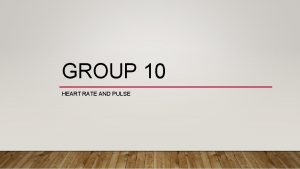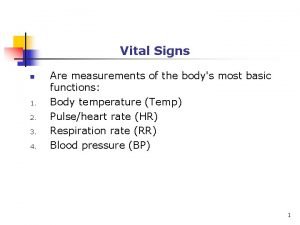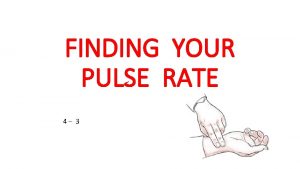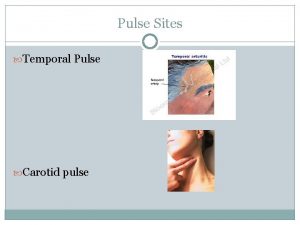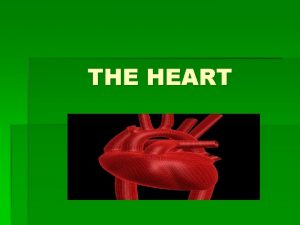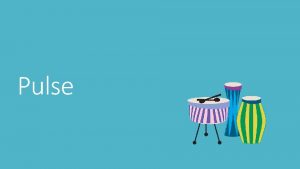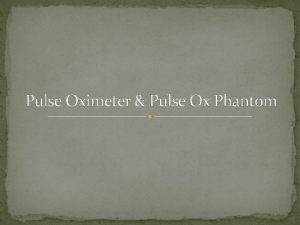GROUP 10 HEART RATE AND PULSE HEART RATE








- Slides: 8

GROUP 10 HEART RATE AND PULSE

HEART RATE • Heart rate, also known as pulse, is the number of times a person's heart beats per minute. Normal heart rate varies from person to person, but a normal range for adults is 60 to 100 beats per minute. • However, a normal heart rate depends on the individual, age, body size, heart conditions, whether the person is sitting or moving, medication use and even air temperature. Emotions can affect heart rate; for example, getting excited or scared can increase the heart rate. • Most importantly, getting fitter lowers the heart rate, by making heart muscles work more efficiently. A welltrained athlete may have a resting heart rate of 40 to 60 beats perminute. • Your heart is a muscle and just like strengthening other muscles by doing activities, you can do the same thing with your heart, ". • Knowledge about your heart rate can help you monitor your fitness level, and it may help you spot developing health problems if you are experiencing other symptoms. • Heart rate and Pulse • Your pulse is your heart rate, or the number of times your heart beats in one minute. Pulse rates vary from person to person. Your pulse is lower when you are at rest and increases when you exercise (more oxygen-rich blood is needed by the body when you exercise.

DIFFERENCES BETWEEN HEART RATE AND PULSE • The heart rate is the number of times the heart beats in the space of a minute. . The pulse rate is exactly equal to the heartbeat, as the contractions of the heart cause the increases in blood pressure in the arteries that lead to a noticeable pulse. Taking the pulse is, therefore, a direct measure of heart rate. • Differences between heart rate and blood pressure • Some people confuse high blood pressure with a high heart rate. Blood pressure is the measurement of the force of the blood against the walls of arteries while heart rate is the number of times your heart beats per minute. • There is no direct correlation between the two, and high blood pressure, or hypertension, does not necessarily result in a high heart rate, and vice versa. Heart rate goes up during strenuous activity, but a vigorous workout may only modestly increase blood pressure.

HOW TO MEASURE HEART RATE • The easiest places to measure your heart rate, according to the AHA, are: • Wrists • inside of an elbow • side of the nec • Top of the foot

RESTING HEART RATE • Your resting heart rate is your pulse when you are calmly sitting or lying. It’s best to measure your resting heart rate it in the morning before you get out of bed, according to the AHA. For adults 18 and older, a normal resting heart rate is between 60 and 100 beats per minute (bpm), depending on the person’s physical condition and age. For children ages 6 to 15, the normal resting heart rate is between 70 and 100 bpm, according to the AHA. • But a heart rate lower than 60 doesn’t necessarily mean you have a medical problem. Active people often have lower heart rates because their heart muscles don't need to work as hard to maintain a steady beat. Athletes and people who are very fit can have resting heat rate of 40 bpm. • A resting heart rate lower than 60 could also be the result of taking certain medications. "Many medications people take especially medication for blood pressure, such as the beta blockers, will lower your heart rate, ". • If coupled with symptoms, a low heart rate may signal a problem. • "A low heart rate in somebody who is having dizziness and light-headedness may indicate that they have an abnormality that needs to be looked at.

MAXIMUM AND TARGET HEART RATE • There is no definitive medical advice on when a resting heart rate is too high, but most medical experts agree that a consistent heart rate in the upper levels can put too much stress on the heart and other organs. If a person has a high heart rate at rest and is experiencing other symptoms, doctors may examine his or heart function, Bauman said. • Knowing your heart rate during workout sessions can help know whether you are doing too much or not enough, the AHA says. When people exercise in their "target heart zone, " they gain the most benefits and improve their heart's • A person's target heart rate zone is between 50 percent and 85 percent of his or her maximum heart rate, according to the AHA. • Most commonly, maximum heart rate is calculated by subtracting your age from 220. For a 30 -year-old person, for example: 220 – 30 = 190. • The target zone for a 30 -year-old person would be between 50 and 85 percent of his or her maximum heart rate: • 50 percent: 190 x 0. 50 = 95 bpm • 85 percent: 190 x 0. 85 = 162 bpm • For a 60 -year-old person, the target zone would be between 80 and 136 bpm. • You can either manually calculate your heart rate during exercise or use heart rate monitors that wrap around the ches or are included in sports watches

LOWERING A RAPID HEART RATE • Pulse rates can spike due to nervousness, stress, dehydration and overexertion. Sitting down and taking slow, deep breaths can generally lower your heart rate. Exercising and getting fitter will usually lower heart rate, too. • Cooling down after a workout session or strenuous activity is important, according to the AHA. Because your heart is beating faster, your body temperature is higher and your blood vessels are dilated, stopping too fast could make you feel sick or even pass out. • The AHA recommends stretching and walking. Stretching helps reduce the buildup of lactic acid, which cause cramps and stiff muscles. Follow these tips: • Walk for about 5 minutes, or until your heart rate gets below 120 beats per minute. • Stretch, and hold each stretch 10 to 30 seconds. If you feel you need more, stretch the other side and return for another set of stretching. • The stretch should be strong, but not painful. • Do not bounce. • Breathe while you’re stretching. Exhale as you stretch, inhale while holding the stretch. •

CLINICAL CORRELATIONS • A number Of conditions can affect your heart rate. • Arrhythmia • Tachycardia • Bradycardia • Arrhythmia • An arrhythmia causes the heart to beat too fast, too slow or with an irregular rhythm. • • Tachycardia is generally considered to be a resting heart rate of over 100 bpm. It is generally caused when electrical signals in the heart's upper chambers fire abnormally. If the heart rate is closer to 150 bpm or higher, it is a condition known as supraventricular tachycardia (SVT). In SVT, your heart’s electrical system, which controls the heart rate, is out of whack. This generally requires medical attention. • Bradycardia : Bradycardia is a condition where the heart rate is too low, typically less than 60 bpm. This can be the result of problems with the sinoatrial node, which acts as the pacemaker, or damage to the heart as a result of a heart attack or cardiovascular disease.
